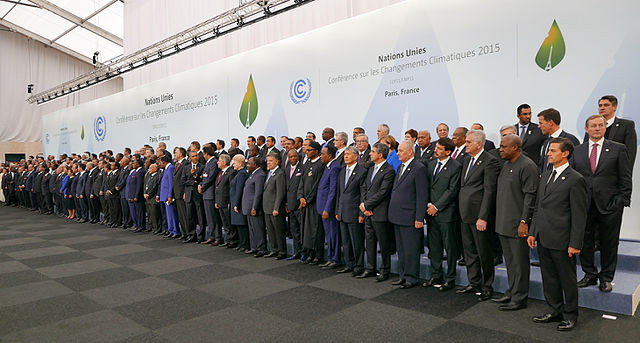
Negotiators twice used a powerful yet little-known South African consensus process—Indaba—to rescue foundering talks at international climate change conferences.
Introduced at the 2011 Durban talks, the recently-concluded 2015 Paris talks also invoked indaba (pronounced “in-dar-bah”) to reduce “900 bracketed points of contention in the draft text to about 300 before the last session“—making it possible for the first time for all 195 countries present to agree to reduce carbon emissions.
Indaba has been used at Zulu, Xhosa, and Swazi tribal gatherings for two centuries or more.
“A message was therefore conveyed..to the King, inviting Umtassa to come in to an indaba at Umtali.”
—The Pall Mall Gazette, London, December 26, 1894 (earliest documented written use)
What is Indaba?
Indaba is not a clearly defined format. The term has been appropriated and adapted (example) and I’ve been unable to find detailed descriptions of the original South African process. I suspect the form used at the Paris Talks does not define Indaba and may distort or omit significant features. Here are the key ingredients from the Paris talks:
- Negotiators used Indaba as a logjam-breaking technique after traditional negotiating process ground to a halt.
- Participants with decision-making authority worked in small groups that included members from countries with seemingly incompatible goals.
- Small group members shared verbally and face-to-face their “red lines”. These were specific “hard limits” issues they were not willing to compromise on.
- Participants who shared hard limits were concomitantly responsible for proposing solutions to other group members. This prevented the meeting from being merely a presentation of position statements.
The Durban climate change conference implemented a more open process. Diplomats representing the main countries formed a standing circle in the middle of hundreds of delegates and talked directly to each other. John Vidal reported: “By including everyone and allowing often hostile countries to speak in earshot of observers, it achieved a remarkable breakthrough within 30 minutes.”
The third and fourth covenants listed above distinguish Indaba from other forms of group consensus and negotiation process: explicit sharing of what is not acceptable, coupled with a commitment to propose and explore solutions for supposedly intractable differences.
Similar consensus processes
A couple of more recent formats are reinventions of Indaba principles.
One is concordance, developed by Will Schutz (here’s an introduction). Robert McNeil summarizes as follows: “Everyone who has a stake is in. Anyone can veto. If you veto, you have to explain why (openly and honestly). We explore the vetoes openly and do the work necessary for all to agree.”
Another is the “two circles” couples work technique for finding common ground popularized by John M. Gottman & Nan Silver in The Seven Principles for Making Marriage Work, in which you draw two circles, one inside the other, using the inner circle to list aspects you can’t give in on and the outer circle for aspects you can compromise over.
[Know any others? Add them in the comments below!]
The overlooked importance of good group process
It’s remarkable that such an elementary consensus process proved to be key to creating a meeting agreement that will likely profoundly shape the future of our planet.
In addition, it’s incredible that such a powerful process is virtually unknown to most meeting designers, negotiators, and facilitators!
In conclusion, the outcome-changing application of indaba at the United Nations Conference on Climate Change demonstrates that there is an urgent need for all of us to become familiar with and use good group processes when we meet to learn, connect, engage, and decide. The world will be a better place when we do.
How do you facilitate change? In this occasional series, we explore various aspects of facilitating individual and group change.
Image “COP21 participants – 30 Nov 2015 (23430273715)” courtesy of Presidencia de la República Mexicana

Hi Adrian! Thank you for your post. My perspective is that every indigenous culture on the planet, developed good processes for airing and resolving conflicts — it is part of our cultural legacy as hunter-gatherers for hundreds of thousands of years, before the emergence of “civilization” and its hierarchical forms of organization. Many indigenous cultures have preserved these traditions (along with much other valuable cultural knowledge) in the face of tremendous challenges to their very survival, from the predatory practices of “civilization”… and, just as modern humans are “rediscovering” the principles and practices of ecological and sustainable living, so too are we “rediscovering” ways to work effectively with one another…
You asked about processes for helping groups arrive at consensus / shared understanding. One empathy-based approach I practice is called Dynamic Facilitation. It is similar in some ways to indaba, in that participants who have a concern about any proposed solutions, are also invited to offer their own solutions.
When I taught this process at a workshop in Hawai’i many years ago, our hosts had invited an indigenous elder to give a talk to us the evening before the workshop started. This elder described the traditional h’o p’ono p’ono process the way that she practiced it. It turned out to have many intriguingly parallels to the work that we do! Though of course, since many indigenous peoples have a strong orate tradition, they don’t need to use chart paper and markers to write everything down… they could just remember it! 🙂 🙂 🙂 Thanks again for your post, and all best wishes…
Rosa, thank you for adding Dynamic Facilitation to my list of parallel processes. Those interested can find out more at http://www.co-intelligence.org/P-dynamicfacilitation.html
Hi Adrian,
This is very interesting – thank you for providing this information! I’m very interested in the process of consensus and didn’t know it was used at the Paris Conference on Climate Change. I’m impressed – and hopeful. Presently I’m working on my second book on community building 🙂
Lori
Very interesting. Reminds me of the consensus based decision making process I observed growing up in the University Friends Meeting (Quakers) in Seattle. Thank you for sharing.